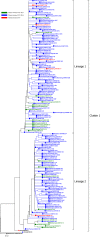Molecular characterization of measles viruses in China: Circulation dynamics of the endemic H1 genotype from 2011 to 2017
- PMID: 31220172
- PMCID: PMC6586441
- DOI: 10.1371/journal.pone.0218782
Molecular characterization of measles viruses in China: Circulation dynamics of the endemic H1 genotype from 2011 to 2017
Abstract
Due to the Expanded Program on Immunization (EPI) and supplementary immunization activities (SIAs) in China, the incidence of measles in China has decreased extensively. The incidence reached its lowest levels in contemporary history in 2012 and 2017, with incidence rates of 4.6 and 4.3 per million population, respectively. However, more than 147,000 measles cases were reported from 2013 to 2016. Furthermore, the proportions of cases in infants < 8 months and adults have been increasing since 2013, representing a considerable challenge for measles elimination in China. A total of 14,868 measles viruses were isolated from confirmed measles cases from 2011 to 2017, of which 14,631 were identified as the predominant endemic genotype, H1; 87 were identified as genotype A viruses that were vaccine associated strains; and 150 were identified as non-H1 genotype viruses. The non-H1 genotype viruses included 62 D8 viruses, 70 D9 viruses, 3 D11 viruses, 14 B3 viruses, and 1 G3 virus, which were identified as imported or import-related viruses that caused sporadic cases or small outbreaks. Most of the transmission chains detected during the period 2011-2012 were interrupted and were followed by many new transmission chains of unknown origin that spread, causing a large measles resurgence in China during 2013-2016. After 4 years of measles resurgence and continuous implementation of the routine immunization program and SIAs, the population immunity reached a sufficiently high level to interrupt most of the transmission chains; only a few strains survived, which continued to be sporadically detected in China in 2017. In the present study, the results from the combined epidemiological and molecular virological data demonstrated the great progress towards measles elimination in China by the further analysis of circulation dynamics for the endemic H1 genotype measles virus from 2011 to 2017. And this study accumulated critical baseline data on circulating wild-type measles viruses in China and provides comprehensive information to the world. These comprehensive baseline data provide evidence to support measles elimination in the future, not only in China but also in other countries worldwide. In addition, the information will be very useful to other countries for tracing their sources of measles cases and for identifying transmission links, which can help prevent potential measles outbreaks.
Conflict of interest statement
The authors have declared that no competing interests exist.
Figures





References
Publication types
MeSH terms
LinkOut - more resources
Full Text Sources
Medical

